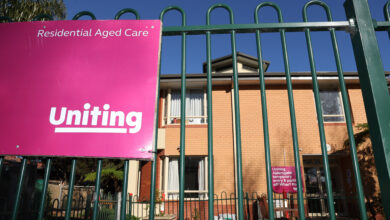Filling the staff gap
With a predicted shortfall of about 100,000 nurses by 2025, many people say one of the main problems is the shortage of graduate positions in the nation's hospitals. By Flynn Murphy
In the last issue of Nursing Review we reported on the widespread cuts to front-line services taking place around Australia. Cuts in Queensland have continued in the face of opposition from industry groups, unions and health academics.
But direct cuts to health services are not the only thing that will affect the strength of Australia's nursing workforce into the future.
Workplace dissatisfaction, a lack of funding and widespread incapacity to convert graduate nurses into full-time practitioners, and the system's increasing shift away from bed-based care to outpatient services, along with Australia's oft-discussed aging population, have many asking just when the nurse shortage will reach crisis level.
The federal government is currently reviewing the findings of the Health Workforce Australia (HWA) - a government initiative established to research and recommend changes to Australian health workforce policy to ensure it can meet future needs. HWA's report points to a dangerous downward trend that, if unchecked, will lead to a chronic shortage of nurses in the future.
One projection, which takes into account Australia's ageing healthcare workforce and the burden of disease, shows that if current trends continue, Australia will suffer from a shortfall of around 109,000 nurses by 2025.
NR drilled deeper into the findings of HWA's report - Health Workforce 2025 - with HWA chief executive officer Mark Cormack. "The projected nursing shortage is a complex problem. It will take a co-ordinated national response involving governments, professional bodies, colleges, regulatory bodies, the higher education system and training providers to bring about a solution," Cormack said.
But the 109,000 shortfall proves a rather conservative prediction when tempered with anecdotal evidence about the current state of the health system.
Australian Nursing Federation (ANF) federal secretary Lee Thomas said Australia was already experiencing a critical lack of nursing and midwifery staff across the public and private sector in hospitals, nursing homes and mental health facilities, with rural and regional areas worst affected.
It's not a new problem. A 2005 Australian Productivity Commission report found that despite the general workforce increasing at nearly double the rate of the population, there were already workforce shortages in nursing and allied health, and a significant number of trained health workers were choosing to shun the sector.
Cormack acknowledged that most stakeholder groups, and the available evidence, suggested the existing health system was in undersupply. In a statement, he said that there was no consistent method of identifying a pre-existing shortage, but that HWA had also modelled a projection that assumed a current nursing undersupply of five per cent. This model predicted a 2025 undersupply of 122,000 nurses.
Cormack said one feature of the system likely to impact nurse numbers in the future was an increase in demand based on changed community expectations about health. Based on a national demand increase of 2 percentage points, this model predicted a 2025 undersupply of 193,000 nurses.
There were variables that could tip the scales the other way, too, including productivity gains which could be achieved through changing models of care, broader scopes of practice for nurses, and changes in technology - such as the federal government's new eHealth system.
But HWA's best-case scenario, which factored in productivity gains of five per cent over the period to 2025 (which Cormack described as "realistic, if not ambitious"), still predicted a shortfall of around 25,000 nurses Australia-wide.
Cormack said the projected shortages would be more pronounced in aged care and mental health, and that a reduction in the supply of internationally trained nurses could further exacerbate the gap between demand and supply.
However the variables are tweaked, it's plain to see Australia is facing a shortfall.
Thomas labelled the HWA report a "dire prediction about the massive nursing shortage Australia faces." She said one strategy the union was pursing to future-proof the profession was a new national campaign to fund employment and clinical placements for graduate nurses.
The union this month launched the "Stop passing the buck, Australia's grads need jobs," campaign.
Thomas said the "buck-passing" referred to chronic bickering between state and federal governments, evidenced by a Nursing Careers Allied Health report which quoted the federal Health Department as saying graduate positions were an issue for the states and private businesses. "The country urgently needs more funded places for undergraduate nursing and midwifery courses ... [to build] a future nursing workforce that will replace the current nursing staff who will be retiring over the next 15-20 years," she said.
Tasmanian ANF branch secretary Neroli Ellis said Tasmania was one of the states worst hit by the issue of graduate positions for nurses, with 375 graduates competing for around 110 public sector and 30 private positions available next year.
Thomas added that the union would continue pressure on state and federal governments to provide more competitive wages for the nursing and midwifery workforce, as well as improving training, education, and career pathways to aid recruitment and improve retention rates. She said retention rates would drop even further if improvements were not made to nurse-to-patient ratios, wage levels and conditions.
"Unless the governments act now ... we fear more and more nurses and midwives will leave the profession, with no one coming through to replace them."
Thomas said in light of the predicted shortfall, the health cuts continuing to take place were "near-sighted and nonsensical".
She said they showed scant regard for the long-term health of the community. Referring to Queensland, she said: "These slash and burn budget-cuts will dramatically impact the amount of safe, quality, patient care our nurses and midwives can deliver, whether it be in a hospital emergency department, a maternity ward, a mental health unit, or a community health facility."
"Crude cost-cutting measures achieved through the loss of nursing jobs and the closure of hospital beds will only lead to excessive and dangerous workloads for nursing and midwifery staff, compromised patient care, longer patient stays in emergency departments and a blow-out in elective surgery waiting times throughout the public hospital system."
Thomas said it was these workplace conditions that were leading to dissatisfaction among nurses.
Email: [email protected]




